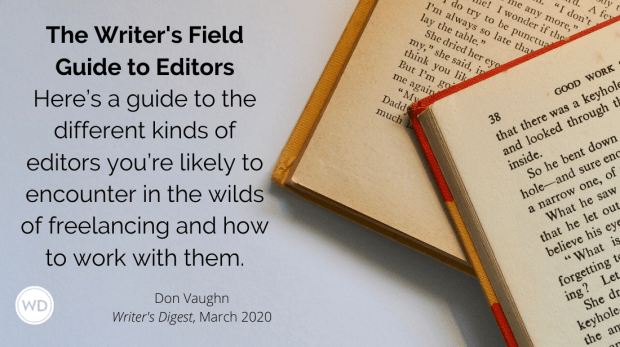Freelancers are sure to come across every type of editor during their career. Here’s a veteran writer’s catalog of all the types you’ll encounter and how to work with each.

Spend enough time in the freelance trenches, and you’ll find yourself working for an eclectic array of editors. If you’re lucky, the majority will be talented individuals who have your best interests at heart, work hard on your behalf, and use their skills to make your words shine.
Unfortunately, not all editors epitomize the ideal. Some are quirky, difficult to work with, and sometimes just plain weird. Here’s a guide to the different kinds of editors you’re likely to encounter in the wilds of freelancing and how to work with them.
The Withholder. Typically short on details when making an assignment, the Withholder can be among the most frustrating editors a writer will work with. Even if they know what they want, they have difficulty conveying it, frequently leaving the writer to struggle for direction. The resulting article may be in the ballpark but not quite there, forcing the writer to make unexpected and time-consuming revisions that could have been avoided with stronger editorial guidance.
The best way to work with a Withholder is to politely demand specifics about an assignment and push until you receive them. Pointed questions will help: Do you want the direction of the article as proposed in my query, or do you have other thoughts? Are you good with the sources I have suggested, or are there others you would like me to talk to? Can you give me a tentative headline? This last question can be especially helpful because it distills the theme of an article down to a single sentence.
The Tyrant. This particular editor believes they get the best work from their writers by brutalizing them. No matter how good your article is, it’s never good enough. Your lede is horrible, and your sources stink. Then comes the demand for multiple revisions, none of which are really necessary. Understandably, the Tyrant is responsible for driving more skilled writers out of the profession than any other, because who wants to work for a jerk?
The Tyrant is a bully and needs to be dealt with as such. Refuse to put up with their badmouthing, and demand the respect you deserve. Question their demand for multiple revisions, and force them to be specific with their reasoning: What exactly is wrong with this or that? The Tyrant may eventually acquiesce and your relationship may improve, but don’t count on it. At the end of the day, you may have to ask yourself whether the paycheck is worth the abuse. If it becomes too much, walk away. There are many more markets in the freelance sea.
The Ditz. Super nice with a fun personality, the Ditz can nonetheless be a challenge for the writers with whom they work because they are scattered and unfocused. The Ditz will lose your contract or your manuscript or your invoice or all three. They’ll forget to submit your invoice to accounting, so you have to wait longer to get paid. They edit hastily, resulting in factual errors that, unfortunately, carry your byline.
A firm but gentle hand and ongoing communication are the best ways to work with a Ditz. “Just a reminder” emails confirming receipt of everything from your manuscript to your invoice will help prevent time-draining screw ups, and occasional, brief phone chats will help cement your relationship and keep everything effectively moving forward. To prevent editorial errors, ask to review prepublication galleys.
The Micromanager. This editor means well, but can’t help harassing their writers with nonstop advice, questions, and general nitpicking. Often a former freelance writer themselves, they believe they know best about everything and refuse to trust their writers to do their job properly. Freelancers often find the Micromanager so frustrating to work with that they walk away from the market.
Overcoming a Micromanager’s tendency to nitpick every aspect of an assignment can be difficult. However, it often helps to have a deep conversation about a project at the time of assignment to make sure you both are on the same page regarding content, direction, and more. This will help put the Micromanager at ease and allow you to get the job done with minimal editorial interference.
The Ghost. A polar opposite of the Micromanager, the Ghost will give you an assignment then suddenly disappear. Emails go unanswered, phone calls unreturned. After a while, contributors begin to wonder if the Ghost is still employed by the magazine.
The Ghost isn’t a bad person, they’re usually just overworked and understaffed. As a result, communication with contributors suffers. If you have questions or need specific guidance over the course of a project, it helps to let the Ghost know exactly how pressing the situation is, and that you need a response ASAP. Say so in the subject line of emails and when leaving a phone message. Emergencies, when noted as such, tend to get a response much more quickly than what may be considered less important communication.
The Mercurial. This editor isn’t just quirky, they’re literally unstable. Their numbers are few, but when you start writing for one, you’ll realize it right away. The Mercurial can be inexplicably mean and nasty, experience bizarre mood swings, turn wildly judgmental, and change their mind about minor matters without reason or explanation. One day you’re the best writer they’ve ever worked with, the next day you’re the worst.
The Mercurial can be a skilled and knowledgeable editor, but their idiosyncrasies, unprofessional tendencies, and general weirdness often drive away their best writers. If you find yourself working for one, you’ll have to ask yourself if it’s worth it in the long run. If the Mercurial likes you, the situation could be fine. If they don’t, your life will be miserable. The question then becomes: How badly do you need the job?
The pro. Skilled, experienced, and always at the top of their game, the Pro is the best kind of editor a writer can hope for. They love their job and enjoy helping writers make their work the very best it can be.
The Pro views their contributors as colleagues rather than subordinates and works closely with them to ensure that every article is top-notch. They work hard to make sure everyone is on the same page regarding an article’s direction and content, explain their edits and editorial changes, and ask writers for their input throughout the process. Lastly, they provide prepublication galleys for review, thus giving their writers a final opportunity to make a piece better still.
Working for a Pro can make freelance writing a dream job, so don’t hesitate to show your appreciation by letting them know how much you enjoy writing with them, and why. A kind word will go a long way in making their day.

Be First to Comment